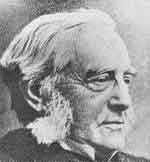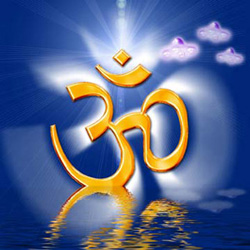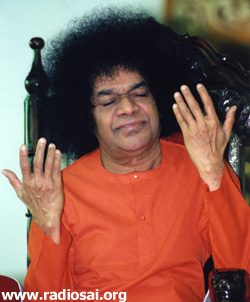 |
 |
 |
 |
| Volume
4 - Issue 04 APRIL 2006 |
|
|
MUSINGS FROM PRASANTHI NILAYAM THE UPANISHADS – THEIR SIGNIFICANCE IN GENERAL Loving Sai Ram and greetings from Prashanti Nilayam. This is my third talk on the Veda Walkthrough Series, if I might call it that. In the two earlier talks, I sort of gave a general introduction to the Vedas. In the present one, I shall draw pointed attention to one particular Upanishad, the TaittriyaUpanishad, for the simple reason that it not only offers a good sample of what the Vedas are all about at the highest level, but also because we often hear this chanted when Swami comes out for Darshan. Radio Sai has of course presented earlier a detailed series on this particular Upanishad and I hope at least some of you have heard that presentation. Many of my remarks are in fact based on that presentation but they would be quite brief compared to what was offered earlier. I have already pointed out that the Upanishads form a part of Vedanta, Vedanta meaning that which comes towards the end of the Vedas. As such, the Upanishads are highly philosophical in content, which ought not to be surprising because, as I mentioned in one of my earlier talks, Vedic thought evolved with time. There are many Upanishads, but scholars consider ten of them to be the most important ones; the Taittriya Upanishad, which I am now considering, is one of this top ten. The Meaning of ‘Upanishad’ The disciple absorbs Wisdom from the Guru and becomes enlightened. This is the traditional and outward meaning. The deeper meaning is that the individual must move nearer and nearer to the True Inner Self, for God is Ultimate Guru; that is the real way to Wisdom. The individual, as Swami often reminds us, is an Embodiment of the Eternal Atma, that is to say, Atma cloaked in a Mind and a body. This combination is also referred to as the Jivatma. The Upanishads help the Jivatma to embark on a voyage of discovery. Discovery of what? Discovery of the Jivatma’s True Nature. And what is that True Nature? The Pure, Unadorned, Unembodied and Infinite Atma. As Professor Radhakrishnan says, “The Atma is what remains when everything that is not the True Self is discarded.” Sadhana is the process by which the Jivatma discards all the unnecessary trappings that cloud the Atma. Upanishadic Thought Echoed by Plotinus
Max Mueller on the Upanishads No one can deny that this is a remarkable and independent perception of the essence of Upanishadic Truth. But the fact remains that the Upanishads outweigh in sheer quantity as well as depth, the insight gained by seekers elsewhere. This is not to comment adversely on other philosophical traditions. Rather, it is a fact of history that in ancient India , seeking the Inner Self literally became a way of life for a very large number of people. Thus it is that Max Mueller, to whom Swami often makes references, says:
This is what Swami Himself has to say about the Upanishads in general.
The Taittriya Upanishad Let me now come to the Taittriya Upanishad, the focus of the present talk. It consists of three parts, each referred to as a Valli; the three parts are: Sikshavalli, Anandavalli, and Bhriguvalli. The first part is essentially connected with a theoretical knowledge of the scriptures. Here a Guru instructs his disciples on some basics. Mere theory is of no use, and God has to be experienced; then alone would one know what Ananda or Bliss is. But Bliss cannot be experienced by one who is in the grip of ignorance. Thus, the first task in moving towards Bliss is to get rid of ignorance. The Anandavalli part of the Taittriya Upanishad deals with this aspect. Finally, there is the Bhrguvalli which is in the form of a dialogue between Sage Varuna and his son Bhrigu, and deals with the Knowledge of the Supreme of Brahman. In a sense, it is a recap of Anandavalli but in dialogue form. So much for a brief introduction as to what three Vallis are all about.
What exactly is the meaning of seeking Brahman? Why were these young men in quest of God Almighty? If indeed the young disciples were in quest of the Supreme One, then how come most of them later ended up getting married and thereby immersed in the turbulent sea called family life? Some clarifications concerning these questions are necessary so that we can appreciate better the teachings and the purpose of the Upanishads. What is truly remarkable about the Vedas and the Upanishads is that they do not dismiss anything in Creation; everything has a place and a purpose, and evolution must take place against this background. Thus it is that Swami Nikhilananda says:
The last remark is perhaps relevant in the context of what is happening today, when man is not only dominating, but even wiping out many living species. Getting back to the uniqueness of the Upanishads, they not only instruct in rituals but, besides giving hints of their inner meanings, indicate how man, bound as he presently is, can elevate himself to experience the Divine, or the Ultimate-Ultimate as Prof. Radhakrishan refers to Brahman. As far as we are concerned, we shall focus primarily on the Universal aspects of the teachings of the Upanishads. We end this brief introduction by quoting what Swami says about Sikshavalli. He says:
Swami adds that merely by routinely discharging one’s duties as a good householder, one cannot cross the Ocean of Life. That calls for something more, and that is presented in the later Vallis. The Guru’s Teaching in the Sikshavalli Portion Let me now quickly present some of the highlights of Sikshavalli. As I told you a short while ago, the word Siksha means instruction. Thus, the Sikshavalli consists essentially of teachings by the Guru to the sishyas or disciples. The disciples being young, there are a number of practical matters that are given attention. For example, the Guru stresses to the student that correct pronunciation and intonation are important since they determine the meaning. There must be no slackness in these. This particular instruction of the Guru has a special relevance to this day and age. The performance of Vedic rituals has declined sharply in the last fifty years or so, and not many of the few priests available for performing rituals are bothered about proper pronunciation. This is not only unfortunate but also a betrayal on the part of the priests concerned. By the way, one should not imagine that Upanishads are pure philosophy. Often they offer a mix of the practical with the philosophical. However, even behind the so-called practical, that is the ritual, there is deep philosophy. For example, while performing Yajnas, priests offer cooked rice to the sacred fire and chant a chant a Mantra. People may think it is all a ritual but in the Gita, Krishna explains the deeper significance of it all. This Mantra in the Gita that I am referring to is the Brahmaarpanam Sloka that we all chant before eating. In effect, everything is by God and for God. This perspective must always be kept in mind. Correct chanting is no doubt very important but that does not mean that the student reduces himself to a tape recorder. It is quite likely that through long and disciplined chanting, the student might end up focussing entirely on just the words. To prevent this from happening and to uplift the student, the Guru also has a hymn through which the attention of the student is directed to the inner significance of the hymns. The student is advised that he must contemplate upon the hymns and their meanings. According to the Upanishads, meditation can be done in two different ways. One is with an eye on the benefits that would accrue and the other is without any concern for worldly gains. Thinking about God for realising worldly gains is all right up to a point but should not be the ultimate goal. The Taittriya Upanishad, though it leans heavily on high philosophy, does not entirely frown upon having worldly desires; instead, it recommends that desires must be kept in check and blended with acts that benefit Society. Thus it is that the householders are asked to give charity in abundance, even while they are praying for wealth.
Vedic seers asked their students to meditate on the word, its deeper significance, the capacity to speak, and see therein the power of God. For us, all this is a reminder that the power of speech must be used only for good and never for bad. A Practical Teaching The Guru’s teachings cover not only aspects of the highest Spiritual Knowledge but also a lot of practical advice. As Swami reminds us often, mere bookish knowledge is of no use; what is equally if not more important is practical knowledge, namely, how to apply the principles of Spirituality in daily life. Thus, the Guru says that when the disciple leaves the Ashram and enters life after getting married, he has the duty to give generously, with love, without the expectation of anything whatsoever in return, and never unwillingly. In other words, sharing is the best way of showing that one really cares. Indeed, one must not merely share food, and wealth, but, most important of all, God’s Love. That is what the Gita also declares, and Swami repeatedly emphasises. So much for the highlights of the Sikshavalli. Now the Upanishads cater to the entire spectrum of aspirants. In a modern school, we have many classes like the first standard, the second standard and so on, all the way to high-school level classes. Naturally, the level of instruction varies with the class. In the Gurukulas of ancient times, there were no classes because the number of disciples was usually a handful. Keeping this in mind, the hymns catered to students with all levels of spiritual evolution. There was no such thing as the same formula for all; instead, it was a case of “each according to his capacity”. The Conclusion of the Sikshavalli The Sikshavalli ends with a remarkable exhortation by the teacher to the student. Swami quotes this often, besides which this exhortation invariably forms a part of the invocation at the commencement of the Institute Convocation. The Guru tells the disciple: Sathyam Vada, Dharmam Chara, Matrudevo Bhava,Pitu Devo Bhava, Acharya Devo Bhava, Athithi Devo Bhava etc. I am sure everyone knows what these stand for. Basically, they exhort the disciple to always abide by Truth, to be righteous, to revere mother, father, Guru and guest, verily as God personified. These are incredible pieces of advice. And how relevant these are today! The Anandavalli Portion I now turn to the Anandavalli portion of the Taittiriya Upanishad. We recall first Swami’s remark that God is the Embodiment of Pure Bliss. That is why He once sang: “Bliss is My Form,” a song familiar to all of us. The Sanskrit word for Bliss is Ananda. The word Ananda is not easy to translate. Often, Ananda is translated as joy or happiness; both these words are totally inadequate; by comparison, Bliss does a better job. Joy and happiness relate to experiences we have in this world. Joyful experiences are no doubt nice but they also have an opposite, which is pain or misery. By contrast, Bliss or Ananda has no opposite. How come? Because, Bliss belongs to the non-dual world, that is the world of God. In as much as man is a child of God, his true nature also is Bliss. But once man gets immersed in the world, he gets easily duped and starts readily accepting fakes like worldly and sensual pleasure as being Bliss. The senses con him, and he gets caught in a trap; again and again he goes for sensory pleasures even though they bring misery in the end. The question might be asked. “There is a man who diligently follows all that the Vedas prescribe. He is good, he is honest, gives charity and all that. Should this not lead him to Bliss?” Well, it is nice to be a good person, perform all duties and rituals diligently and so forth. But all that would not and cannot ever lead to ultimate union with God. Why? Because of attachment. Even a good man has desires, though they may seem harmless. For example, many good people want to go to heaven after death. This may seem alright superficially but heaven is the wrong destination! That is why Swami says that even Sattva binds; it is like a golden rope! Then what does one do? One must become UNBOUND, which means one must shed all body-consciousness. The Goal of Life In the Anandavalli, the Teacher gently draws the attention of the young disciple to what exactly the goal of life ought to be. One ought not to get sucked in and become overwhelmed by the turbulence of life. One must look far beyond, never losing sight of the final destination. Why must one do that? Because, that is where Eternal Joy and Bliss lie. The student must realise that there is a God beyond description by words and beyond the understanding of the Mind, notwithstanding its enormous power. The Guru urges the disciple to be bold and seek this Supreme Being who is beyond the physical world and the Mind too. The Guru stresses that it is only the one who seeks Brahman who can enjoy Eternal Bliss. I must also call attention to the fact that in Anandavalli, the Supreme God or Brahman is described as Sathyam, Jnanam and Anatham, i.e., as Truth, Knowledge and the Infinite. In fact, Swami often sings a Bhajan starting with these very words; these words are from the Anandavalli. In summary, Anandavalli is a road map to Eternal Bliss. The Bhriguvalli Portion The Bhriguvalli which is the last of the three vallis that form a part of the Taittriya Upanishad, is essentially a repeat of the Anandavalli but in a different format. In this, Bhrigu, the son of Rishi Varuna asks a question of his father about Brahman. The father, who in this case is also the Guru, asks the son who is also the disciple, to think, meditate, and come back with the answer. In other words, the answer is to be found by self-enquiry and not via tuition. The disciple does as told and come back with what he thinks is the answer. The father says go back and meditate some more. Why? Because the answer is not complete and represents only a part of the Truth. The disciple goes and comes back a few times, and every time he is sent back to enquire more. However, it is not an infructuous exercise altogether because in every attempt, the disciple manages to refine the answer he found earlier. And finally there comes a stage when the disciple does not come back to report. Why? Because, having found that Brahman is nothing but Absolute Bliss or Ananda, he becomes one with It! There is nothing more to find out or discover!! That in essence is the gist of Bhriguvalli. In other words, it gives hints about how exactly one must enquire while seeking the Ultimate Truth. Swami’s Words on Anandavalli and Bhriguvalli Before I wrap up, let us hear what Swami has to say about Anandavalli and Bhriguvalli. Swami says,
Well, that brings me to the end of what I wish to say today. I hope I have succeeded in giving a broad-brush overview of one of the important Upanishads. Allow me to end by playing for you from our collection, the three vallis, just to give you a flavour of how Taittriya Upanishad sounds. Click here to listen to Taittiriya Upanishad. [46 kb] Jai Sai Ram. - Heart2Heart Team |
| You can write to us at : h2h@radiosai.org |
Vol 4 Issue 04 - APRIL 2006
|
Best viewed in Internet Explorer - 1024 x 768 resolution. |
DHTML Menu by Milonic. |




 There is an idea behind this particular advice of the Guru. In later life, many disciples may be engaged in assisting with the performance of Vedic rituals. If rituals are performed, they must be done so in the proper manner, which means that Mantras must be chanted properly. I have already called attention in an earlier talk to the importance attached by the Kanchi Paramacharya to the sound aspect.
There is an idea behind this particular advice of the Guru. In later life, many disciples may be engaged in assisting with the performance of Vedic rituals. If rituals are performed, they must be done so in the proper manner, which means that Mantras must be chanted properly. I have already called attention in an earlier talk to the importance attached by the Kanchi Paramacharya to the sound aspect.
 Swami says, “The purpose of life is to prepare you to return to your natural habitat. From God you have come and to God you must return.” What does this mean and how does one go about it? That is the issue dealt with in Anandavalli.
Swami says, “The purpose of life is to prepare you to return to your natural habitat. From God you have come and to God you must return.” What does this mean and how does one go about it? That is the issue dealt with in Anandavalli. 